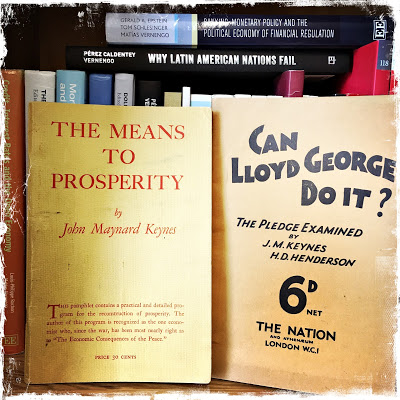Keynes' 1933 and 1929 pamphlets, respectively One of the many unfair criticisms of Keynes' General Theory (GT) is that is badly written or somewhat incomprehensible. Note that Keynes started to write it in 1932, four years into the Depression, and two years after publishing the Treatise, which he probably thought was going to be his Magnus Opus. In other words, by the time he started to write the GT the worst part of the Depression was coming to an end (the UK had abandoned gold in 1931, and the US would start the Mew Deal the following year). Keynes' policy advice, mostly about the need to abandon gold and promote public works was not based on the GT, which came considerably later.As he said, the book was basically for his fellow economists. More importantly the book marked a theoretical
Topics:
Matias Vernengo considers the following as important: General Theory, Great Depression, Keynes, pamphleteer
This could be interesting, too:
Lars Pålsson Syll writes The Road Not Taken
Matias Vernengo writes Paul Davidson (1930-2024)
Matias Vernengo writes Keynes’ denial of conflict: a reply to Professor Heise’s critique
Matias Vernengo writes Was Keynes a Liberal or a Socialist?
One of the many unfair criticisms of Keynes' General Theory (GT) is that is badly written or somewhat incomprehensible. Note that Keynes started to write it in 1932, four years into the Depression, and two years after publishing the Treatise, which he probably thought was going to be his Magnus Opus. In other words, by the time he started to write the GT the worst part of the Depression was coming to an end (the UK had abandoned gold in 1931, and the US would start the Mew Deal the following year). Keynes' policy advice, mostly about the need to abandon gold and promote public works was not based on the GT, which came considerably later.
As he said, the book was basically for his fellow economists. More importantly the book marked a theoretical break with neoclassical economics, one that was NOT necessary to promote public works or expansionary fiscal policy that would come to be associated with Keynesianism (he was advocating that before he reached the main conclusions of the GT). The point of the book was that, even with price and wage flexibility, the economic system did not have a tendency to full employment (that means you must wait for chapter 19, when wage flexibility is introduced, to get his main argument).
The fact that the Keynesian Revolution led to a reinterpretation of Keynes on the basis of rigid wages (or interest rates) or some other kind of imperfection in more modern versions of mainstream Keynesianism, suggests that to some extent Keynes the pamphleteer was more effective than the theorist, which is not altogether surprising, since Keynes was indeed very good at writing for greater audiences, and became internationally known as a result of his pamphlet on the Treaty of Versailles.
This is my list of his most influential essays or pamphlets:
- The Economic Consequences of the Peace
- The Economic Consequences of Mr. Churchill
- The End of Laissez-Faire
- Can Lloyd George Do it? (with H. Henderson)
- Economic Possibilities for our Grandchildren
- The Means to Prosperity
- My Early Beliefs

